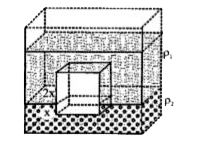If a body is immersed in a fluid, it experiences an upward force called the buoyant force. The magnitude of buoyant force depends on (a) the size or volume of the body and (b) the density of the fluid. How large is this buoyant force? The answer to this question was discovered by the Greek Philosopher and mathematician Archimedes (287-212B.C) and is known as Archimedes Principle which states that ‘When a body is immersed wholly or partly in a fluid, it experiences an upthrust equal to the weight of the fluid displaced by it'. This principle holds for bodies of any shape and for fluids of even non-uniform density. The necessary condition for a body to float in a liquid is that the weight of the liquid displaced by the immersed portion of the body must be equal to the weight of the body.
A cubical-block of density ρ floats completely immersed in two non-mixing liquids of densities ρ1andρ2 as shown in Fig. The relation between ρ,ρ1andρ2 is

A
ρ=12(ρ1+ρ2)
B
ρ=2ρ1+ρ2
C
ρ=13(2ρ1+ρ2)
D
ρ=13(ρ1+2ρ2)
Text Solution
The correct Answer is:C
Each side of the block =3x. For floating, weight of the block = upthrust due to liquid of density ρ1 upthrust due to liquid of density ρ2.
(3x)3ρg=(3x)2×2x×ρ1g+(3x)2×x×ρ2g⇒ρ=13(2ρ1+ρ2)
|
Similar Questions
Knowledge Check
The buoyant force depends on the
Adepth of a liquidBdensity of a liquidCcolour of a liquidDNone of theseThe buoyant force depends on the
Adepth of a liquidBcolour of a liquidCdensity of a liquidDnone of theseThe buoyant force depends upon
Adensity of the liquidBvolume of the body inside the liquidCvalue of g at that placeDall the above
Which law/principle states that when a body is immersed fully or partially in a fluid, it experiences an upward force that is equal to the weight of the fluid displaced by it?
View SolutionThe magnitude of buoyant force depends on the …… of the fluid.
View SolutionIf the density of a liquid increases, the buoyant force will
View SolutionWhen a body is wholly or partially immersed in a liquid it experiences a buoyant force which is equal to the
View SolutionThe magnitude of buoyant force depends on which one of the following properties of fluid ?
View Solution
